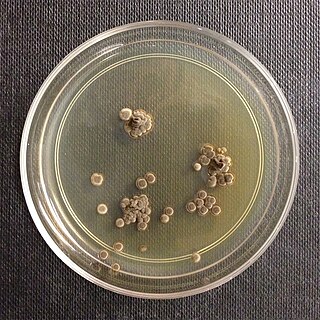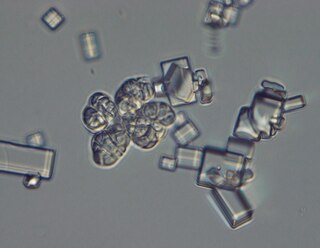Halotolerance is the adaptation of living organisms to conditions of high salinity. Halotolerant species tend to live in areas such as hypersaline lakes, coastal dunes, saline deserts, salt marshes, and inland salt seas and springs. Halophiles are organisms that live in highly saline environments, and require the salinity to survive, while halotolerant organisms can grow under saline conditions, but do not require elevated concentrations of salt for growth. Halophytes are salt-tolerant higher plants. Halotolerant microorganisms are of considerable biotechnological interest.

Aureobasidium pullulans is a ubiquitous and generalistic black, yeast-like fungus that can be found in different environments. It is well known as a naturally occurring epiphyte or endophyte of a wide range of plant species without causing any symptoms of disease. A. pullulans has a high importance in biotechnology for the production of different enzymes, siderophores and pullulan. Furthermore, A. pullulans is used in biological control of plant diseases, especially storage diseases.

Hortaea werneckii is a species of yeast in the family Teratosphaeriaceae. It is a black yeast that is investigated for its remarkable halotolerance. While the addition of salt to the medium is not required for its cultivation, H. werneckii can grow in close to saturated NaCl solutions. To emphasize this unusually wide adaptability, and to distinguish H. werneckii from other halotolerant fungi, which have lower maximum salinity limits, some authors describe H. werneckii as "extremely halotolerant".

The Wallemiomycetes are a class of fungi in the division Basidiomycota. It consists of the single order Wallemiales, containing the single family Wallemiaceae, which in turn contains the single genus Wallemia. The phylogenetic origin of the lineage was placed to various parts of Basidiomycota, but according to the analysis of a larger dataset it is a sister group of Agaricomycotina. The genus contains species of xerophilic molds that are found worldwide. The seven described species are distinguished by conidial size, xerotolerance, halotolerance, chaotolerance, growth temperature regimes, extracellular enzyme activity profiles, and secondary metabolite patterns. They are typically isolated from low-moisture foods, indoor air dust, salterns and soil. W. sebi is thought to be one of the causes of the hypersensitivity pneumonitis known as the farmer's lung disease, but since the other species were recognised and separated from W. sebi only recently, their role in the disease cannot be excluded.
Cladosporium dominicanum is a fungus found in hypersaline environments. It has globoid conidia. It has also been found in plant material.
Cladosporium psychrotolerans is a fungus found in hypersaline environments. It grows well at 4 °C but not at 30 °C, and has ornamented, globoid conidia with long digitate projections.
Cladosporium velox is a fungus found in hypersaline environments. It has globoid conidia. It has also been found in plant material.
Cladosporium spinulosum is a fungus found in hypersaline environments. It has globoid, ornamented conidia with long digitate projections.
Cladosporium halotolerans is a fungus found in hypersaline environments. It has globoid conidia. It has also been isolated from bathrooms and in a dolphin.
Cladosporium fusiforme is a fungus found in hypersaline environments. It has ovoid to ellipsoid conidia. It has also been found in animal feed.
Cladosporium salinae is a fungus found in hypersaline environments. It has ovoid to ellipsoid conidia. It has also been found in animal feed.
“Black yeasts”, sometimes also black fungi, dematiaceous fungi, microcolonial fungi or meristematic fungi is a diverse group of slow-growing microfungi which reproduce mostly asexually. Only few genera reproduce by budding cells, while in others hyphal or meristematic (isodiametric) reproduction is preponderant. Black yeasts share some distinctive characteristics, in particular melanisation of their cell wall. Morphological plasticity, incrustation of the cell wall with melanins and presence of other protective substances like carotenoids and mycosporines represent passive physiological adaptations which enable black fungi to be highly resistant against environmental stresses. The term "polyextremotolerance" has been introduced to describe this phenotype, a good example of which is the species Aureobasidium pullulans. Presence of 1,8-dihydroxynaphthalene melanin in the cell wall confers to the microfungi their characteristic olivaceous to dark brown/black colour.

Wallemia ichthyophaga is one of the three species of fungi in the genus Wallemia, which in turn is the only genus of the class Wallemiomycetes. The phylogenetic origin of the lineage was placed to various parts of Basidiomycota, but according to the analysis of larger datasets it is a (495-million-years-old) sister group of Agaricomycotina. Although initially believed to be asexual, population genomics found evidence of recombination between strains and a mating type locus was identified in all sequenced genomes of the species.
Aureobasidium subglaciale, formerly known as Aureobasidium pullulans var. subglaciale, is a ubiquitous black, yeast-like fungus that is found in very cold habitats. As the name suggests, it was primarily isolated from subglacial ice of arctic glaciers. The species was established when the genomes of the four former varieties of Aureobasidium pullulans were sequenced and the large differences between them were discovered.
Aureobasidium melanogenum, formerly known as Aureobasidium pullulans var. melanogenum is a ubiquitous black, yeast-like fungus that is found mainly in freshwater habitats. The species also includes strains causing human infections, which were previously classified as A. pullulans. It was named due to abundant melanin production and accumulation in the cell walls, which leads to dark green, brown or black appearance of the cells and colonies The species was established when the genomes of the four former varieties of Aureobasidium pullulans were sequenced and the large differences between them were discovered.
Aureobasidium namibiae, formerly known as Aureobasidium pullulans var. namibiae is a ubiquitous black, yeast-like fungus. It was described on the basis of only one strain isolated from dolomitic marble in Namibia. The species was established when the genomes of the four former varieties of Aureobasidium pullulans were sequenced and the large differences between them were discovered.
Fungal genomes are among the smallest genomes of eukaryotes. The sizes of fungal genomes range from less than 10 Mbp to hundreds of Mbp. The average genome size is approximately 37 Mbp in Ascomycota, 47 Mbp in Basidiomycota and 75 Mbp in Oomycota. The sizes and gene numbers of the smallest genomes of free-living fungi such as those of Wallemia ichthyophaga, Wallemia mellicola or Malassezia restricta are comparable to bacterial genomes. The genome of the extensively researched yeast Saccharomyces cerevisiae contains approximately 12 Mbp and was the first completely sequenced eukaryotic genome. Due to their compact size fungal genomes can be sequenced with less resources than most other eukaryotic genomes and are thus important models for research. Some fungi exist as stable haploid, diploid, or polyploid cells, others change ploidy in response to environmental conditions and aneuploidy is also observed in novel environments or during periods of stress.

Passalora is a genus of fungi in the family Mycosphaerellaceae. It has about 250 species.
Dothiora is a genus of fungi belonging to the family Dothioraceae.





